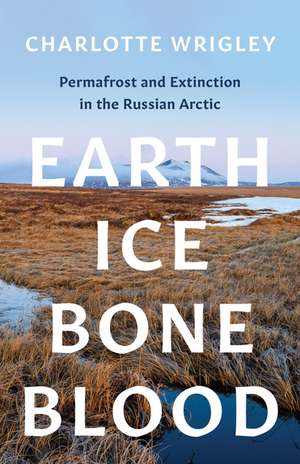Earth, Ice, Bone, Blood: Permafrost and Extinction in the Russian Arctic
Autor Charlotte Wrigleyen Limba Engleză Paperback – 4 apr 2023
Climate scientists point to permafrost as a “ticking time bomb” for the planet, and from the Arctic, apocalyptic narratives proliferate on the devastating effects permafrost thaw poses to human survival. In Earth, Ice, Bone, Blood, Charlotte Wrigley considers how permafrost—and its disappearance—redefines extinction to be a lack of continuity, both material and social, and something that affects not only life on earth but nonlife, too.
Earth, Ice, Bone, Blood approaches the topic of thawing permafrost and the wild new economies and mitigation strategies forming in the far north through a study of the Sakha Republic, Russia’s largest region, and its capital city Yakutsk, which is the coldest city in the world and built on permafrost. Wrigley examines people who are creating commerce out of thawing permafrost, including scientists wishing to recreate the prehistoric “Mammoth steppe” ecosystem by eventually rewilding resurrected woolly mammoths, Indigenous people who forage the tundra for exposed mammoth bodies to sell their tusks, and government officials hoping to keep their city standing as the ground collapses under it. Warming begets thawing begets economic activity— and as a result, permafrost becomes discontinuous, both as land and as a social category, in ways that have implications for the entire planet. Discontinuity, Wrigley shows, eventually evolves into extinction.
Offering a new way of defining extinction through the concept of “discontinuity,” Earth, Ice, Bone, Blood presents a meditative and story-focused engagement with permafrost as more than just frozen ground.
Preț: 154.88 lei
Nou
Puncte Express: 232
Preț estimativ în valută:
29.64€ • 30.94$ • 24.53£
29.64€ • 30.94$ • 24.53£
Carte disponibilă
Livrare economică 14-28 martie
Livrare express 27 februarie-05 martie pentru 22.87 lei
Preluare comenzi: 021 569.72.76
Specificații
ISBN-13: 9781517911829
ISBN-10: 1517911826
Pagini: 256
Ilustrații: 31 black and white illustrations
Dimensiuni: 140 x 216 x 10 mm
Greutate: 0.31 kg
Editura: University of Minnesota Press
Colecția Univ Of Minnesota Press
ISBN-10: 1517911826
Pagini: 256
Ilustrații: 31 black and white illustrations
Dimensiuni: 140 x 216 x 10 mm
Greutate: 0.31 kg
Editura: University of Minnesota Press
Colecția Univ Of Minnesota Press
Notă biografică
Charlotte Wrigley recently finished her PhD in Human Geography at Queen Mary University, London, and is postdoctoral fellow at the University of Stavanger.
Recenzii
"A myth-busting, pioneering ride through climactic upheaval in the Russian Arctic, where extinction is not an end but a becoming. Charlotte Wrigley’s tales of life and matter, death and survival co-mingle, surprise, disrupt, and provoke. Masterful riffs about time across scales reimagine worlds beyond the hubris of scientific technofixes and other false promises of redemption."—Jennifer E. Telesca, author of Red Gold: The Managed Extinction of the Giant Bluefin Tuna
"Charlotte Wrigley challenges what we know—or think we know—about permafrost, the finality of extinction, and the role humans play in the Anthropocene. An engaging and thought-provoking read."—Jonathan C. Slaght, author of Owls of the Eastern Ice: A Quest to Find and Save the World’s Largest Owl
"Grounded in the permafrost landscapes of northern Siberia, Earth, Ice, Bone, Blood traverses issues fundamental to our time: the meanings of extinction, the experiences of earth-shaking change, the seductions of engineering both genetic and geological. Told through the many lives—and possible death—of permafrost, Charlotte Wrigley’s theoretically rich narrative pushes us to imagine better worlds."—Bathsheba Demuth, author of Floating Coast: An Environmental History of the Bering Strait
"Earth, Ice, Bone, Blood rewards its readers with its sensory experience and its philosophical meditations, arming them with new questions with which to challenge their own slow-churning surroundings."—Science Magazine
"Wrigley’s sustained and disparate application of the notion of discontinuity to a wide array of environmental questions makes for a sophisticated, thought-provoking, and often brilliant exploration that enriches scholars’ understandings of how non-living entities can intrude into human endeavors in unexpected ways."—Andy Bruno, The Russian Review
"Charlotte Wrigley challenges what we know—or think we know—about permafrost, the finality of extinction, and the role humans play in the Anthropocene. An engaging and thought-provoking read."—Jonathan C. Slaght, author of Owls of the Eastern Ice: A Quest to Find and Save the World’s Largest Owl
"Grounded in the permafrost landscapes of northern Siberia, Earth, Ice, Bone, Blood traverses issues fundamental to our time: the meanings of extinction, the experiences of earth-shaking change, the seductions of engineering both genetic and geological. Told through the many lives—and possible death—of permafrost, Charlotte Wrigley’s theoretically rich narrative pushes us to imagine better worlds."—Bathsheba Demuth, author of Floating Coast: An Environmental History of the Bering Strait
"Earth, Ice, Bone, Blood rewards its readers with its sensory experience and its philosophical meditations, arming them with new questions with which to challenge their own slow-churning surroundings."—Science Magazine
"Wrigley’s sustained and disparate application of the notion of discontinuity to a wide array of environmental questions makes for a sophisticated, thought-provoking, and often brilliant exploration that enriches scholars’ understandings of how non-living entities can intrude into human endeavors in unexpected ways."—Andy Bruno, The Russian Review
